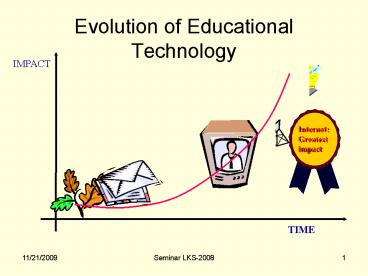Evolution of Educational Technology - PowerPoint PPT Presentation
1 / 17
Title:
Evolution of Educational Technology
Description:
... more than textbooks online? Content centric, transmission model ... Games. WebQuest. Experiment. Role-playing. Trouble shooting. Problem solving Composing ... – PowerPoint PPT presentation
Number of Views:193
Avg rating:3.0/5.0
Title: Evolution of Educational Technology
1
Evolution of Educational Technology
IMPACT
TIME
2
Rationale for using technology
- Increased teacher productivity
- Freeing time to work with students
- Provide more accurate information quickly
- Produce more student-friendly materials (use of
multimedia elements)
- Support for new instructional approaches
- Cooperative learning
- Shared Intelligence and knowledge
- Problem solving and higher-level skills
3
Rationale for using technology
- Motivation
- Gain learner attention
- Engage learner through productive activity
- Increased perception of control
- Unique instructional capabilities
- Link learners to information resources
- Help learners visualize problems and solutions
through images and animation - Track learners progress
- Link learners to learning tools
4
Definitions of e-learning
- 'E-learning refers to learning activities that
involve computers and networks. (The Internet and
intranets are considered networks.) E-learning
does not require learning materials to be
delivered by computer, but computers and networks
must be involved in this type of learning.
(Becta, UK) - 'DEL (distributed and electronic learning) can be
represented as a spectrum ranging from
Internet-supported distance learning in which the
learner has limited physical contact with the
tutor or other learners, to teacher-led,
classroom-based activity which is interspersed
with occasional computer-delivered or facilitated
assignments. (Edna, Australia)
5
6
The Role of the Teacher/Instructor
7
The Challenges of Education Today
- Liberal arts education to vocational education
and human resource development - creating knowledge workers in science and
technology - Theoretical to practical
- Single discipline to Multidisciplinary to
Integrated Knowledge - Knowledge as Truth to Knowledge as Relative
- Childhood to Adult to Lifelong learning
- Education for a few to Education for all
(democratization of education) - Learning as an individual process to Learning as
an institutional phenomenon (learning
organizations) - Teacher-centred to Student-centred
- Rote learning to Learning as reflection and
application - Face-to-face to Distance to E-learning to Mobile
learning
8
Conclusion
- Integrating educational technology refers to the
process of determining which electronic tools and
which methods for implementing them are
appropriate for a given situation and problem - Direct technology resources to specific problems
and needs - Instructional technology resources for students
- Productivity applications for teachers
- Anticipate and plan for change
- Separate fad from fact
9
The Premise Today
ICT
?
Information and Communication Technologies
10
The Problem
- Most assumes single learner, self-paced learning
- Often little more than textbooks online?
- Content centric, transmission model of education
- what is the implied pedagogy?
11
Academic shovelware.
- The extent to which a student gains the same
pedagogical benefit from a printout of your Web
resources as from the resources themselves is the
extent to which you have done nothing of the
pedagogical value of using the Web.(Fraser,
1999)
12
What is needed in e-learning?
- A rethinking of learning activities and
interactions - Learner engagement
- A meaningful and authentic context for learning
- A setting that challenges learners
- A provision for practice
- Choice of the right tool for the pedagogical task
- (Boud Prosser, 2002)
13
Technology affordances
- Enable visual and oral information display within
a software - Supports constructivist, problem-focused
philosophical orientation - Increased recognition of social collaboration as
part of learning - Computer Mediated communication allows
collaboration breaking the nexus of time and
location - Increasing modularisation of individual elements
that are retrieved from databases and employed in
varied contexts.
14
Introducing Learning Design
- Learning Design is a name given to a new field of
e-learning technology - Learning Design Sequence of Collaborative
Learning Activities - Learning Design can incorporate single learner
content, but also collaborative tasks or
activities such as discussion, voting, small
group debate etc. - Wraps a single-learner Learning Objects with a
sequence of collaborative tasks
15
Anatomy of e-learning
16
Definitions of Learning Object
- Any digital resource that can be reused to
support learning. (Wiley, 2002) - Learning objects are sometimes defined as being
educational resources that can be employed in
technology-supported learning. McGreal (2004) - Learning objects are digital materials used to
create online courses where these materials are
modular, interoperable, reusable and
discoverable. Downes, Stephen(2004) - A learning object is an aggregation of one or
more digital assets, incorporating metadata,
which represents an educationally meaningful
stand-alone unit. Dalziel (2003) - 4. A learning object is a self-contained block
of learning that fulfills a single, stated
learning objective. American Society for
Training Development.1 - 1 See http//www.astd.org
Next
17
e-Learning Model





























